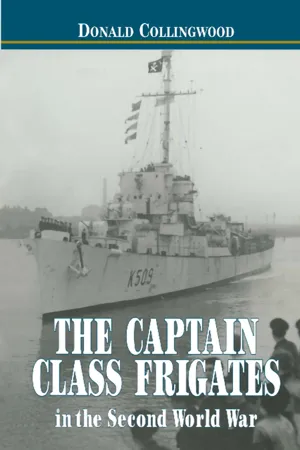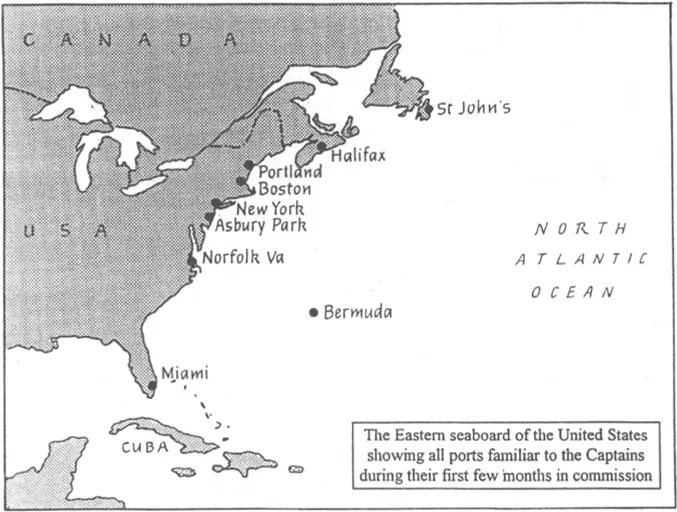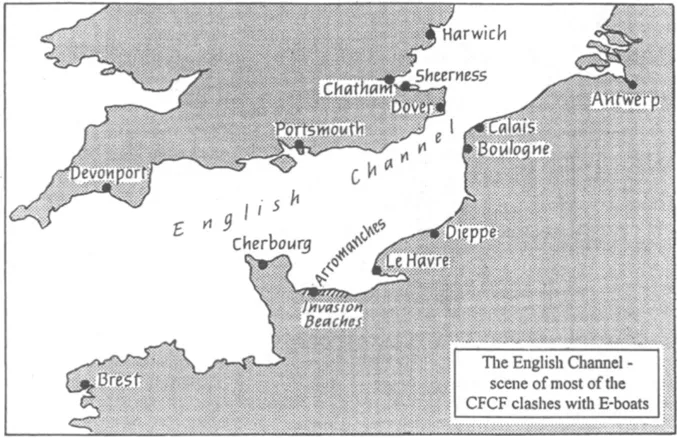
- 208 pages
- English
- ePUB (mobile friendly)
- Available on iOS & Android
eBook - ePub
The Captain Class Frigates in the Second World War
About this book
This is the first book to fully document the story behind the Frigates that played such a vital role during World War Two.
Frequently asked questions
Yes, you can cancel anytime from the Subscription tab in your account settings on the Perlego website. Your subscription will stay active until the end of your current billing period. Learn how to cancel your subscription.
At the moment all of our mobile-responsive ePub books are available to download via the app. Most of our PDFs are also available to download and we're working on making the final remaining ones downloadable now. Learn more here.
Perlego offers two plans: Essential and Complete
- Essential is ideal for learners and professionals who enjoy exploring a wide range of subjects. Access the Essential Library with 800,000+ trusted titles and best-sellers across business, personal growth, and the humanities. Includes unlimited reading time and Standard Read Aloud voice.
- Complete: Perfect for advanced learners and researchers needing full, unrestricted access. Unlock 1.4M+ books across hundreds of subjects, including academic and specialized titles. The Complete Plan also includes advanced features like Premium Read Aloud and Research Assistant.
We are an online textbook subscription service, where you can get access to an entire online library for less than the price of a single book per month. With over 1 million books across 1000+ topics, we’ve got you covered! Learn more here.
Look out for the read-aloud symbol on your next book to see if you can listen to it. The read-aloud tool reads text aloud for you, highlighting the text as it is being read. You can pause it, speed it up and slow it down. Learn more here.
Yes! You can use the Perlego app on both iOS or Android devices to read anytime, anywhere — even offline. Perfect for commutes or when you’re on the go.
Please note we cannot support devices running on iOS 13 and Android 7 or earlier. Learn more about using the app.
Please note we cannot support devices running on iOS 13 and Android 7 or earlier. Learn more about using the app.
Yes, you can access The Captain Class Frigates in the Second World War by Donald Collingwood in PDF and/or ePUB format, as well as other popular books in History & Military & Maritime History. We have over one million books available in our catalogue for you to explore.
Information
CONTENTS
Preface
Acknowledgements
Glosssary of Terms and Abbreviations
Maps
List of Illustrations
1. The Genesis of the Captain Class Frigates
2. The 4th Escort Group
3. The 3rd Escort Group
4. The 1st Escort Group
5. The 5th Escort Group
6. The Coastal Forces Control Frigates
7. DE’s of the Nore Command
8. DE’s in the Portsmouth and Devonport Commands
9. DE’s Employed as Headquarters Ships in the Normandy Invasion
10. The 15th Escort Group
11. The 21st Escort Group
12. Service in Mixed Escort Groups
Bibliography
Appendix ‘A’ The Roll of the Captain Class Frigates
PREFACE
The seventy-eight American built Destroyer Escorts which were allocated to the Royal Navy under Lease Lend agreement and were classified as the Captain class Frigates when commissioned in 1943–44 were part of the massive contribution to the Allied maritime war effort made by Kaiser and the United States Navy shipyards.
The story of their design, construction, working up and eventual operational achievements is a unique and little known facet of the Royal Navy’s history. Many thousands of British sailors served in them and those who survive frequently bewail the fact that their achievements are not more widely appreciated.
I have attempted to remedy this in the chapters which follow. I have covered their whole story as far as my researches and permitted space allow. Life in one escort vessel was very similar to that in sister ships and the exploits of one escort group were very similar to those of others. It is therefore inevitable that there is some similarity between chapters. This was unavoidable if the full story of all the Captains was to be covered and their overall contribution to final victory recorded.
The Destroyer Escorts (or DE’s, as those serving in them persisted in calling them) were essentially escort vessels. Much of their existence in groups assigned purely as Close Escorts was boring and extremely uncomfortable, with the ‘Cruel Sea’ as the main enemy. The German historian Cajus Becker complained that only ten per cent of all Allied convoys were ever contacted by U-boats, a situation confirmed by one of our famous convoy Commodores (Rear Admiral Creighton) who wrote that many convoy commodores, merchant seamen and escort ship crews ploughed the Atlantic routes for four or five years without seeing a ship sunk or hearing a shot fired. The convoy system was nevertheless essential for the protection of our vital supply lines and it was due to the seamanship skills, vigilance and fortitude of the escort ships’ crews that so many of our merchant ships and major naval vessels survived. U-boat actions did not take place every day but when a U boat pack did strike the battle would often be horrifying and bloody.
It is generally accepted that the worst of the battles in the Atlantic were over by 1943, so the Captains were not in commission during the peak period of the U-boat pack actions. Nevertheless, the Captains which served in the roving Support Groups were very successful and sank a commendable number (thirty-six) of U-boats during the last two years of the war. As a matter of fact, a statistical analysis of U-boat sinkings I made some time ago revealed that of the ten major classes of RN escort vessels (comprising some 389 ships), the Captains were the fourth most successful class in locating and destroying U-boats. Their prowess in this respect was only exceeded by the Loch class frigates, the Black Swan class sloops and the converted ‘V and W’ destroyers.
It must be emphasized, however, that battle honours for the North Atlantic were not awarded only to those ships which notched up U boat ‘kills’. Submarine hunting was strictly a team pursuit and those which spent much time in the ‘outfield’ were often as deserving of praise as those which actually scored the runs.
I was privileged to serve as the Ordinance Artificer in Cubitt from November, 1943, to March, 1946, and had first hand knowledge ofthe Captains in Nore Command but in order to write the individual histories which follow, I used information from a number of secondary sources as well as the primary sources in the Admiralty files in the Public Record Office. These are, as Captain Roskill once said, the bare bones of naval history. They have to be fleshed out by those who actually lived that history. This present work would not be as complete as it is without the ‘flesh’ enthusiastically provided by so many men who served in these gallant ships. Some were friends and shipmates, some became friends during the research period and some I have never met in person, but I hope that I have done justice to their memories of the ships, for which we share a common nostalgia. Some of their names are mentioned hereunder but I am sincerely grateful to all who rendered me any assistance however small.
ACKNOWLEDGEMENTS
l owe my thanks to Arsen Charles, one time Curator of the Museum in Charlestown Navy Yard at Boston for giving me copies of so many photographs and documents relating to the building of the Destroyer Escorts and giving permission for publication. I am also grateful to the present Curator for confirming that permission.
My thanks are also due to the Director of the Imperial War Museum (London) for allowing me to include pictures from the extensive collection of ship photos in the Museum archives and to the photographic staff who so willingly assisted me to locate particular photographs.
My warmest thanks to Mrs Wood, widow of the late Lieutenant W. Wood RAN, First Lieutenant of HMS Holmes, for so kindly allowing me to use the reproduction of his painting of that ship.
I am also indebted to the author Peter Elliot, who loaned me copies of a set of wartime signals referring to Royal Naval ship movements in the Western Atlantic in 1943 – 44 which pinpointed early movements of the Captains after commissioning.
During the research period in the early 1980’s, I was also in correspondence with a vast number of men who had served in the Captains and many were able to provide me with valuable information not recorded elsewhere. The list of names is too long for full inclusion here but those who provided the most valued information are mentioned below. It is unfortunate that since my researches began so long ago and publication has taken so long to achieve, some of those mentioned have since ‘Passed the Bar’ and so, sadly, my acknowledgement is posthumous in these cases:
ERA Ashenden; Ron Ayers; Sub-Lieutenant Baggs; Fred Barr; Roy Bentham; John Brady; Alf Brown; W. Burke; Frank Chapman; Les Cheeseman; Commander E. Chavasse; Ron Collision; Captain Feather stone-Dilke; Geoff Finn; Rear Admiral Dudley-Davenport; Frank Dawson; George Dyer; P. R. Elvin; Lieutenant M. Forte; Bill Garland; Geoff Goodchild; S. Grayson; Dennis Grinnell; Lieutenant-Commander A. L. Hammond; B. Harrop; Alan Hope; Vic Jackman; George Lester; S. A. Lewis; Sub-Lieutenant P. Mallett (South Africa) Ken Maltby; William McCoy; N. McElroy; A. McGregor; T. W. McPhail; L. Morton; Dave Murray; Arthur Newton; Frank Owen; A. Penwarden; Frank Phelps; Lieutenant I. Pilditch; Mervyn Price; Bill Read; ‘Robbie’ Robins; Ted Rowson; P. Seaborn; Geo. Seymour; Lieutenant A. Shepherd; Harry Smith; J. Smith; A. Storey; Jim Watts; Phil Webb; R. Willis; Lieutenant W. A. Wood (Australia); Frank Woodley; D. Yeomans; Geo. Young.
To those not mentioned by name, I also extend my most grateful thanks.
Wantage D.J.C.
1998
GLOSSARY OF TERMS AND ABBREVIATIONS
| AA | Anti-Aircraft |
| A and A | Alterations and Additions (to a ship’s original design) |
| AB | Able Seaman |
| AB S/D | Able Seaman submarine detector rating |
| AB S/T | Able Seaman Torpedoman |
| AD | Air defence |
| AP | Armour piercing (ammunition) |
| A/S | Anti-submarine |
| Asdic | The British name for the Sonar submarine detector |
| BRLO | British Resident Liaison Officer |
| Captain (D) | Commander of a destroyer flotilla |
| CERA | Chief Engine Room Artificer |
| CFCF | Coastal Forces Control Frigate |
| CO | Commanding Officer (ie. ship’s Captain) |
| CPO | Chief Petty Officer |
| CPO ‘Buffer’ | Chief Bosun’s Mate (the ’buffer’ between the First Lieutenant and the crew) |
| CTL | Constructive Total Loss |
| CW candidates | Lower deck ratings who were potential officers and undergoing sea experience |
| DC | Depth-Charge |
| D-Day | The day upon which a major operation is to begin. D-Day for the Normandy Invasion was 6 June, 1944. |
| DE | Destroyer Escort |
| DF | Destroyer Flotilla (eg. 1st DF) |
| DSC | Distinguished Service Cross |
| DSM | Distinguished Service Medal |
| DSO | Distinguished Service Order |
| EA | Electrical Artificer |
| E-boat | German high speed Motor Torpedo-boat |
| EG | Escort Group |
| ERA | Engine Room Artificer |
| First Lieutenant | Executive Officer and Second-in-Command of a small ship |
| FOBAA | Flag Officer British Assault Area (in Normandy) |
| FOXER | A noise-making device towed as a decoy to deflect acoustic torpedoes |
| G7E | The standard German electrical torpedo |
| HE | High explosive (ammunition) |
| Hedgehog | Ahead throwing A/S mortar |
| HFDF | High Frequency Direction Finder. A device, known to all as ‘Huff Duff’, for locating submarines by intercepting their radio transmissions. |
| HMCS | His Majesty’s Canadian Ship |
| HMNZS | His Majesty’s New Zealand Ship |
| HSD | Higher Submarine Detector rating (a PO) |
| Jolly Roger | The black and white flag, carrying the skull and crossbones emblem, flown by ships entering harbour from an operation in which they have sunk an enemy submarine |
| KFK | A German barge armed with air defence guns for harbour and canal defence |
| LCF | Landing craft fitted with flame throwers |
| LCG | Landing craft mounting two 4.7″ naval guns and five Oerlikons |
| LCS | LCG converted to fire banks of rockets |
| LTO | Leading Torpedo Operator |
| LENTIL | A German explosive motorboat |
| MGB | Motor Gunboat |
| MO | Medical Officer |
| MTB | Motor Torpedo-boat |
| Mulberry Harbour | Artificial harbour, constructed chiefly out of huge concrete caissons which were towed across the Channel on D-Day, 1944, and sunk off Arromanches |
| NEGER | German manned torpedo |
| NOIC | Naval Officer in Charge |
| Nore Command | The Royal Naval Home Command which had Chatham as its Home Port |
| OA | Ordnance Artificer |
| Oerlikon | A 20mm heavy machine gun (or cannon) firing explosive ammunition for use in the AD role but also used against such targets as surfaced U-boats or E-boats. |
| OOW | Officer of the Watch |
| Ord.Mech | Ordnance Mechanic |
| OS | Ordinary Seaman |
| OYSTER | A German pressure mine |
| Pink List | An Admiralty list issued every four days giving the location of every ship in the Royal Navy in harbour. |
| PO | Petty Officer |
| Pom-Pom | A heavy machine gun firing 2pdr HE shells. Sited right in the bow of a DE for use against E-boats or in the AD role. |
| PT-boat | A USN patrol boat equivalent to the Royal Navy’s MTB |
| RAN | Royal Australian Navy |
| RCN | Royal Canadian Navy |
| RNCVR | Royal Canadian Naval Volunteer Reserve |
| RN | Royal Navy |
| RNR | Royal Naval Reserve |
| RNVR | Royal Naval Volunteer Reserve (wartime commissioned officers held RNVR commissions) |
| SBA | Sick Berth Attendant |
| SO | Senior Officer (Escort Group Leader) |
| SPO | Stoker Petty Officer |
| TBS | Talk Between Ships (radio telephone) |
| T5 ‘GNAT’ | German ZAUNKÖNIG homing torpedo |
| Trout Line | A defensive line of minesweepers and other small craft moored close together to form an extended barrier protecting the Normandy Assault Area |
| U-boat | German submarine (Unterseeboot) |
| USN | United States Navy |
| V & W destroyers | British destroyers of 1918–20 vintage – all with names beginning with V or W |
| WA | Western Approaches |
| W/T | Wireless telegraphy |


LIST OF ILLUSTRATIONS
1. Fargo Barracks, Milk Street, Boston
2. Frazier Barracks, Charlestown Navy Yard
3. Hingham Shipyard
4. The launch of DE-278, HMS Keats
5. HMS Calder – handover and commissioning ceremony
6. HMS Holmes – dressed over all for commissioning.
7. Commander C. Gwinner DSO*, DSC RN. 1st Escort Group
8. Commander D. Macintyre DSO … DSC RN 5th Escort Group
9. Lieutenant Commander R. Hart DSC* RN. 21st Escort Group
10. HMS Conn returns from a successful operation flying the Jolly Roger
11. HMS Inman, the last Captain to be handed over to the Royal Navy
12. HMS Lawford in her role as a headquarters ship for the Normandy Invasion, June, 1944
13. HMS Bickerton crippled by an V-boat’s torpedo during Operation GOODWOOD
14. HMS Duckworth, ‘the Champion’ of the Captains
15. HMS Holmes, from a painting in the collection of the late Lieutenant Bill Wood RANVR
16. An ill fated pair. HMS Lawford and HMS Trollope in Portsmouth Dockyard 26 May, 1944
17. The horrific damage suffered by HMS Whitaker, and a group of survivors
18. Lieutenant Bill Wood RANVR, First Lieutenant of HMS Holmes, on the bridge at sea
19. HMS Goodall, looking aft from the forecastle
20. Sub-Lieutenant Paul Mallet SANF. G...
Table of contents
- Cover
- Full Title
- Copyright
- Table of Contents
- Index